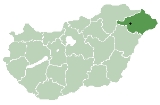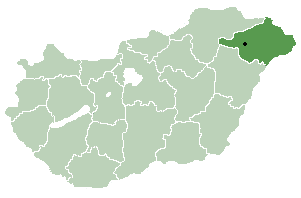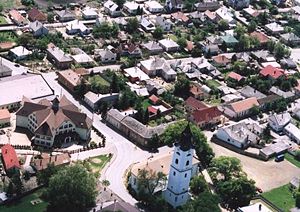
Nagykálló
Encyclopedia

Town
A town is a human settlement larger than a village but smaller than a city. The size a settlement must be in order to be called a "town" varies considerably in different parts of the world, so that, for example, many American "small towns" seem to British people to be no more than villages, while...
in Szabolcs-Szatmár-Bereg
Szabolcs-Szatmár-Bereg
Szabolcs-Szatmár-Bereg is an administrative county in north-eastern Hungary, bordering Slovakia, Ukraine and Romania. It shares borders with the Hungarian counties Hajdú-Bihar and Borsod-Abaúj-Zemplén...
county, in the Northern Great Plain
Northern Great Plain
Northern Great Plain is a statistical region of Hungary. It is part of Great Plain and North region. Northern Great Plain includes the counties of Hajdú-Bihar, Jász-Nagykun-Szolnok, and Szabolcs-Szatmár-Bereg. It is also one of the largest plains in the world with an area of about 3000 square...
region
Region
Region is most commonly found as a term used in terrestrial and astrophysics sciences also an area, notably among the different sub-disciplines of geography, studied by regional geographers. Regions consist of subregions that contain clusters of like areas that are distinctive by their uniformity...
of eastern Hungary
Hungary
Hungary , officially the Republic of Hungary , is a landlocked country in Central Europe. It is situated in the Carpathian Basin and is bordered by Slovakia to the north, Ukraine and Romania to the east, Serbia and Croatia to the south, Slovenia to the southwest and Austria to the west. The...
. Before World War II
World War II
World War II, or the Second World War , was a global conflict lasting from 1939 to 1945, involving most of the world's nations—including all of the great powers—eventually forming two opposing military alliances: the Allies and the Axis...
it belonged to Szabolcs
Szabolcs (county)
Szabolcs is the name of a historic administrative county of the Kingdom of Hungary in present-day northeastern Hungary. The capital of the county was Nyíregyháza.-Geography:...
county.
History
Nagykálló was already an oppidumOppidum
Oppidum is a Latin word meaning the main settlement in any administrative area of ancient Rome. The word is derived from the earlier Latin ob-pedum, "enclosed space," possibly from the Proto-Indo-European *pedóm-, "occupied space" or "footprint."Julius Caesar described the larger Celtic Iron Age...
(market town) in the 14th century. Its name probably comes from the old word kálló meaning "gathering place". Nagy means "large"; this prefix was used to differentiate between Nagykálló and the nearby Kiskálló ("small Kálló"), which later became a part of Nagykálló.
In 1315 King Charles Robert
Charles I of Hungary
Charles I , also known as Charles Robert , was the first King of Hungary and Croatia of the House of Anjou. He was also descended from the old Hungarian Árpád dynasty. His claim to the throne of Hungary was contested by several pretenders...
granted the town rights to hold a market, later the county councils were held here, thus the town became the centre of the region. After the Ottomans burnt the town in 1556, the citizens built a stone castle for defence. In 1603 István Bocskai settled Hajdúk
Hajduk (soldiers)
The Hajduk were Hungarian irregular or mercenary soldiers in the 16th and 17th centuries, and a liveried bodyguard of the Polish-Lithuanian Commonwealth in the 17th and 18th centuries. In Serbia and the Banat region in the 18th century, hajduk referred to an infantry soldier, though the term is now...
in the town. After his death they moved to Hajdúböszörmény
Hajdúböszörmény
Hajdúböszörmény is a city in North Eastern Hungary with a population of approximately 30,000 people. It has a unique circular plan to the streets that is supposed to have originated as a defense from invasion or attack...
, but Nagykálló remained an important industrial centre. It was the property of the Kállay de Nagy-Kálló family.
In 1630 George II Rákóczi
George II Rákóczi
György Rákóczi II , a Transylvanian Hungarian ruler, was the eldest son of George I and Susanna Lorantffy....
occupied the town and issued the Proclamation of Independence here. Francis II Rákóczi
Francis II Rákóczi
Francis II Rákóczi Hungarian aristocrat, he was the leader of the Hungarian uprising against the Habsburgs in 1703-11 as the prince of the Estates Confederated for Liberty of the Kingdom of Hungary. He was also Prince of Transylvania, an Imperial Prince, and a member of the Order of the Golden...
attacked the castle on July 29, 1703 (first battle of the war for freedom) and occupied it the following day. In 1704 he ordered the castle to be destroyed (it was destroyed only later, in 1709). In 1747 the town became the county seat of Szabolcs county, but this role was taken over by Nyíregyháza in 1867. Nagykálló was granted town status again in 1989.
Tourist sights

- Main square with Protestant church, old county hall and Freedom
- Millennium Memorial (1896)
- Protestant church, built around 1710: its belfry, The Rákóczi Tower (60 m, one of the tallest buildings on the Great Hungarian Plain) was built of the stones from the destroyed castle
- Roman Catholic church (18th century, late Baroque)
- Greek Catholic church (18th century, oldest building of the town)
- Jewish cemeteries
- Tomb of Grand RebbeRebbeRebbe , which means master, teacher, or mentor, is a Yiddish word derived from the Hebrew word Rabbi. It often refers to the leader of a Hasidic Jewish movement...
Itzhak Isaac of Kaliv, a shrine visited by Orthodox Jews - Town Museum
- Frigyes KorányiFrigyes KorányiBaron Frigyes Korányi the Younger was a Hungarian politician, who served as Minister of Finance at three times: between 1919–1920, in 1924 and between 1931-1932. His father was the famous internist Frigyes Korányi. Korányi Jr. graduated in Budapest and other universities in Europe...
Memorial House - Harangod: a farmstead near Nagykálló. According to a local legend during the Mongol invasion of Hungary (mid-13th century) the villagers fled Nagykálló to escape the Mongol hordes, and at the urging of their priest they took the church bell with them, so that it won't b destroyed when the Mongols burn the village, but accidentally dropped it into the swamps outside the town. They couldn't save it, but later, when they went back to the town, it is said that sometimes they heard the sound of the bell coming from afar. (The name Harangod means "your bell" in Hungarian; in the legend the people told the priest when they heard the sound of the bell from the swamps: "listen, Father, there's your bell".)
- Hunger Hill: a 12 m high hill with a lookout tower on its top. According to a local legend it was built in 1780, when the people, suffering from a famine, asked their landlord Ferenc Kállay to give them food, and he said he will if they build this hill for him as an interest.
- Spa of Nagykálló
People
- Benjamin von KallayBenjamin von KállayBéni Kállay de Nagy-Kálló or Benjamin von Kállay , Austro-Hungarian statesman, was born in Budapest. His family derived their name from their estates at Nagykálló, in Szabolcs, and claimed descent from the Balogh Semsen tribe, which colonized the counties of Borsod, Szabolcs, and Szatmár, at the...
- Miklós KállayMiklós KállayDr. Miklós Kállay de Nagykálló was a Hungarian politician who served as Prime Minister of Hungary during World War II, from 9 March 1942 to 19 March 1944....
- Imre ÁmosImre ÁmosImre Ámos was a twentieth century Hungarian Jewish painter.Following his studies at the Technical University, Budapest from 1927 to 1929, he enrolled in the Art School where he was a pupil of Gyula Rudnay. He married Margit Anna, also a painter.His painting was initially influenced by József...
(1907, Nagykálló – 1944 or 1945, Germany) was a twentieth century Hungarian Jewish painter. - Frigyes KorányiFrigyes KorányiBaron Frigyes Korányi the Younger was a Hungarian politician, who served as Minister of Finance at three times: between 1919–1920, in 1924 and between 1931-1932. His father was the famous internist Frigyes Korányi. Korányi Jr. graduated in Budapest and other universities in Europe...
(1828. December 10. – Budapest, 1913. május 19.)
Twin town
, MetzingenMetzingen
Metzingen is a Swabian city with about 22,000 inhabitants, in the state of Baden-Württemberg in the southwest of Germany, south of Stuttgart.-History:The city is mentioned for the first time in documents from 1075...
, Limanowa
Limanowa
Limanowa is a small town in southern Poland, in the Lesser Poland Voivodeship. It is the capital of Limanowa County....
, Tasnád
Tasnad
Tăşnad is a town in Satu Mare County, northwestern Romania. It administers five villages: Blaja, Cig, Raţiu, Sărăuad and Valea Morii.-Population:According to the last census from 2002 there were 9,528 people living within the city....
, Técső, Borsi
Borsi
-In Greece:*Borsi, Greece , a village in the northern part of the prefecture of Ilia-In Slovakia:*Borsi is the Hungarian name of the village of Borša in Slovakia.-In India, Asia:*Borsi, India, in the Chhattisgarh state...
, Migueturra

